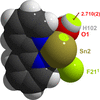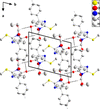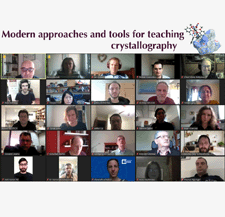issue contents
September 2024 issue

Cover illustration: The present paper reports the crystal structure of the salt poly[[μ-aqua-aquabis(μ3-carbamoylcyanonitrosomethanido)barium] monohydrate], {[Ba(μ3-C3H2N3O2)2(μ-H2O)(H2O)]·H2O}n, in which the Ba ions display a distorted ninefold coordination with four nitroso-, two carbonyl- and three aqua-O atoms as a tricapped trigonal prism. A three-dimensional framework structure is formed by face-sharing of the trigonal prisms, and the solvate water molecules populate the crystal channels. The structure suggests that small resonance-stabilized cyanonitroso anions can be utilized as bridging ligands for the supramolecular synthesis of MOF solids. See: Domasevitch, Senchyk, Ponomarova, Lysenko & Krautscheid [Acta Cryst. (2024). E80, 986–992].
research communications














Puckering effects of 4-hydroxy-L-proline isomers on the conformation of ornithine-free Gramicidin S





















 journal menu
journal menu





































